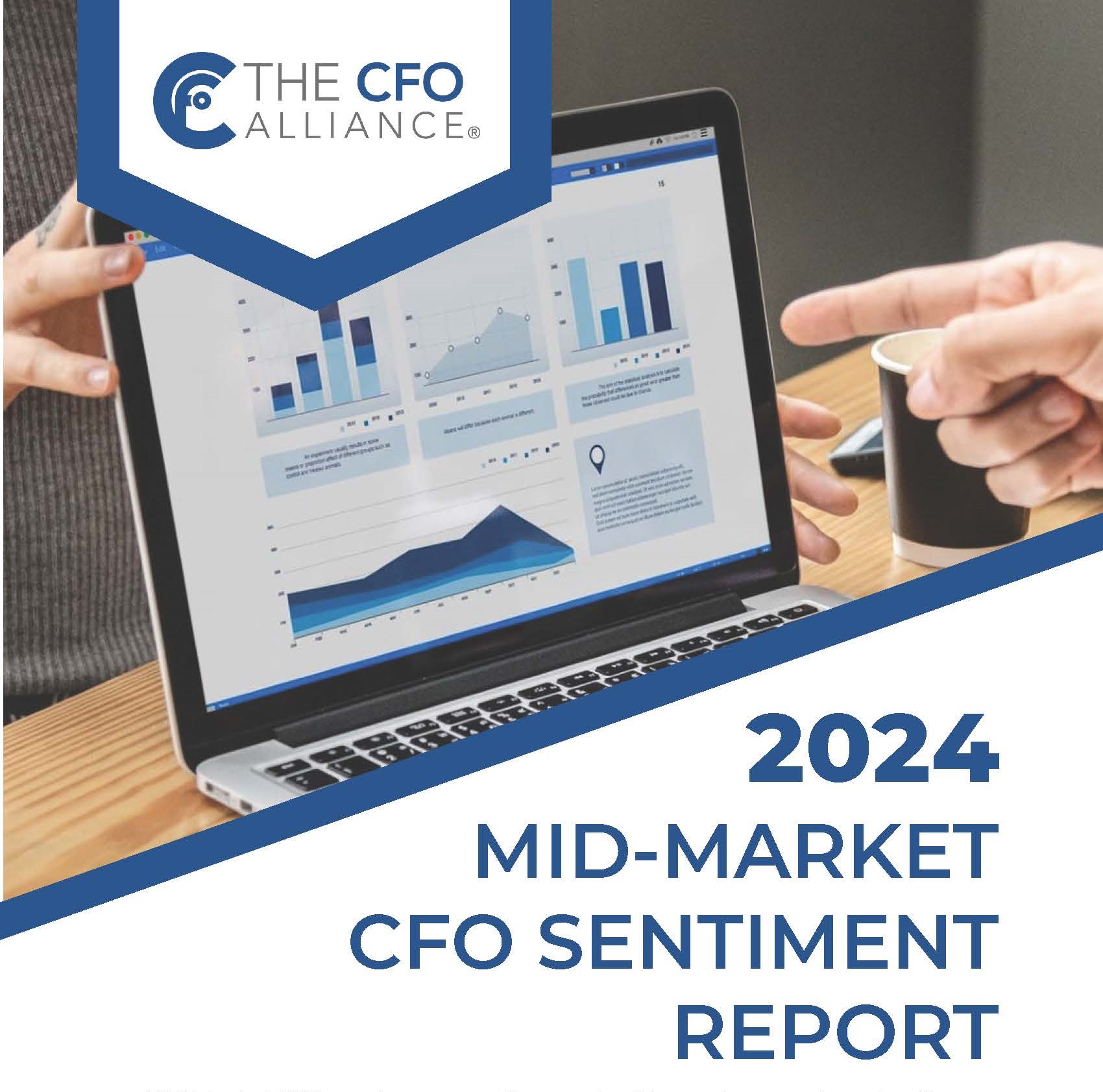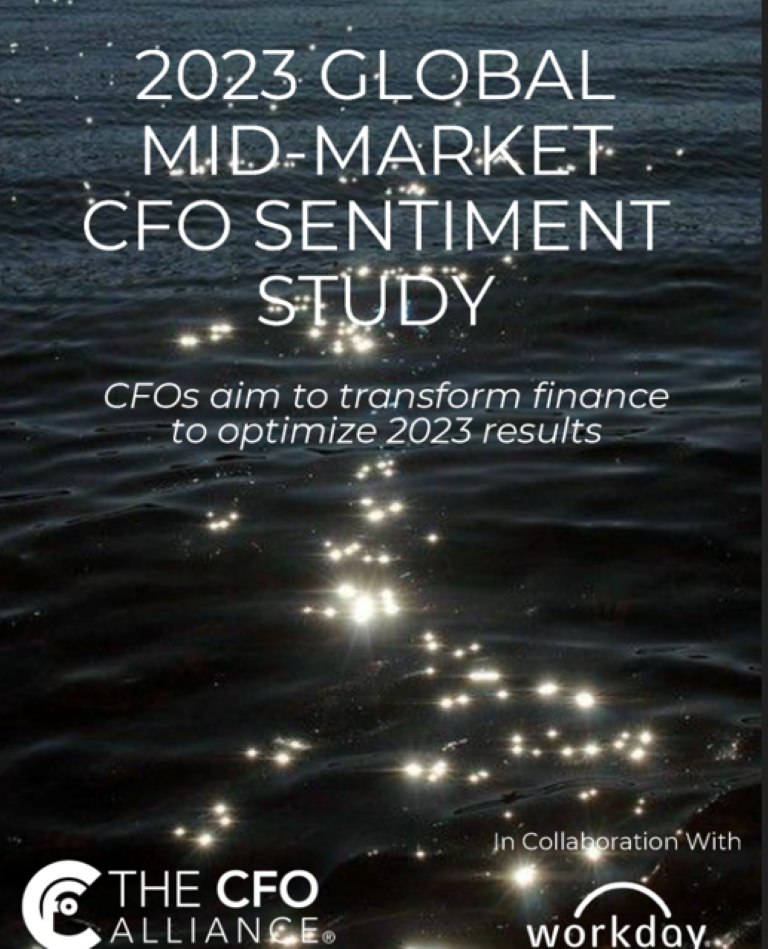The CFO Alliance 2023 Roundtable Series Tells the Story of 2024 Plan Designs and AI’s “Fit.”
The 4th Quarter has always been a misnomer in practical terms for CFOs. The short planning runway for the year ahead makes any Q4, in totality, feel more like New Year's Eve. Certainly not the celebratory side of it but the side that says, “Here’s hoping we’ve got next year planned right.”
As CFOs button up the last cycle of puts and takes on their budgets, credit the revelations and experiences of the COVID era for how annual plan designs have been evolving. And for those inclined to zero in and say, “what a difference one year makes”, insights and learnings from 2023 have triggered a higher level of budget planning rigor in formulating their annual plans.
Although 2023 started out with significant optimism (80% of CFO Alliance Members believing their businesses would hit top- and bottom-line targets), our Mid-Year Checkpoint Report indicated that number had dropped to 50%. Finance was doing its job in optimizing margins, but enterprises found themselves scrambling for scarcer resources across the board (labor, capital, and equipment). Sectors and businesses that were doing well couldn’t capitalize on opportunities because they lacked the resources available to exploit them further, and others experiencing revenue shortfalls had to notch back planned growth investments to a run-in-place position.
Now, as CFOs collectively look ahead to 2024, delivering on the growth imperative in light of persistent economic uncertainty has forced caution and constraint to guide planning assumptions and performance expectations.
- The upside: Real-time vigilance focused on performance indicators and tight controls that can engage quickly if the assumptions and performance disappoint in 2024.
- The downside: Enterprises imitatively act so conservatively that their fears and self-fulfilling prophecies contribute to a stagnant economy.
So, 2024 game plans must be marked by a perfect balance of risk management and growth enablement. And the management process must be distinguished by vigilance, agility, and pre-planned pivots in case any of their what-if scenarios materialize.
About the Roundtables – Principles and Method
- Learning is the greatest force for positive change and rapid advancement of both business and personal goals.
- With a Focus on Finance, CFO Alliance leadership, Members in the Spotlight, and SME Sponsors deliver timely, hyper-relevant content that stimulates critical thinking, problem-solving strategies, best practice sharing, and improves forward visibility of what lies ahead.
- Participants contribute openly and willingly to help each other. The dynamic and constructive interchanges among roundtable participants elevate collaboration to an exceptional level, and “wisdom of the crowd” creates a powerful, high-trust ecosystem where ideas and practical takeaways are generated at a scale exceeding other learning methods.
The 2024 Budgeting Picture
- Companies experiencing a tough 2023, particularly those that are investor-backed and/or carrying significant leverage, are under stakeholder pressure to restart the growth trend, and finance teams face meaningful expectations (if not unreasonable) to deliver a plan that aligns. These expectations have been fanned by less-than-ideal visibility into performance attribution over the last couple of years.
- Revenue, including upside and downside scenarios, is getting a reality check. Finance leaders have been proactive on cost containment, and the low hanging fruit is long gone. The integration of sales pipeline (momentum) into plans to justify the timing of investments and expenses will play a prominent role in stakeholder discussions. “Let’s build it and they will come” won’t survive the plan for revenue trajectory.
- Factors largely outside of companies’ control continue to influence performance. Lately every year has seemed to have its theme – covid, supply chain, great resignation, inflation, interest rates – and many of these persist. Top-performing finance teams are able to isolate these constraints in budget builds and reporting frameworks, influence decision-making around them, and deliver ongoing financial reviews without the cloudiness of constraints’ P&L influence.
- Constraint-Based Budgeting (CBB), a design element of the budgeting process, takes center stage. It assesses and builds out core unit economics around one or more constraints and provides sufficient driver connectivity and data detail that enables finance teams to isolate the impact of the constraint during the budgeting process and throughout the following year in variance and attribution analyses.
- CBB can be used with any approach to budgeting – top-down, bottom–up, driver-based, zero-based (ZBB) and its derivatives. It represents a conscious and purposeful effort to align functional/departmental leads around the business’ constraints, with the following goals:
- Ensure the impact of constraints is clear across functions (e.g., Sales forecast determined by Direct Labor headcount added, as the constraint vs. the gross pipeline).
- Connect related drivers and quantify the flow-through P&L impact of scenarios on either side of the constraint; and,
- Support finance team recommendations and stakeholder dialogue related to investment decisions that influence the constraint (e.g., Are we willing to invest $X to hire Direct Labor earlier than needed and carry those costs to ensure we have the resources we need?)
- By incorporating CBB into the design, development, and dialogue related to the budget process, finance teams deliver more budget buy-in within their organizations, back recommendations with quantifiable justification, effectively bridge the gap on expectations vs. realities with stakeholders, and generally compress the budgeting cycle as a result with fewer iterations.
- Although facing multiple constraints, the primary constraint is revenue visibility based on customer dynamics. Discussions are about periods further into the future, but this brings more variability around customer financial performance into play. It may simply not matter if you are planning for the back half of 2024 if a customer faces financial distress or a bad quarterly earnings report.
- For Constraint-Based Budgeting, companies with these revenue dynamics are digging into fixed and variable costs in a new way, analyzing the level of financial commitment over time tied to material binary revenue outcomes (large purchases, contract renewals). Equipment COGS, particularly those with customization, aren’t variable if you’re committed to the purchase and the customer falls away.
- For budget builds, this means additional scenario analysis on customer-level expectations, increased analysis on the expense base tied to sales performance, and the integration of the sales constraints into functional/department planning that ties expense and investment levels during 2024 to sales and pipeline performance throughout the year. A great many companies will be dancing to the beat of the sales drum in 2024!
- Labor challenges are a primary theme in discussions thus far; while it is its own constraint, teams are digging deeper this year in applying constraints and other factors in their labor planning.
- Binary outcomes can render budget value meaningless if the P&L impact of an event isn’t isolated and/or sensitized; connecting binary events to P&L elements allows teams to quantify the impact of the eventual outcome, preserving other performance analysis and comps to plan.
- Budget mechanics available to address binary outcomes include ‘modules’ with toggles, timing sensitivity, and P&L flowthrough, whereas bottoms-up and ZBB-like approaches allow for item tagging tied to constraints and other aspects of the business (e.g., base business plus growth initiatives)
- The outcome(s) of binary events (e.g., unforeseen distributions or limited capital/liquidity) can wreak havoc on variance analysis to the point of rendering the budget useless shortly after its finalization. If this happens, finance teams lose ongoing opportunities for measuring performance versus expectations and driving accountability to plans throughout the organization. The only way to counter this is to tie components of the P&L build to the constraint input (e.g. “If you take $1m more/less out in distributions, how will that waterfall through the budget in terms of additional investments/expenses/revenue/margin?”).
- One way to implement this is through ‘modules’ within budgeting builds, utilizing yes/no toggles and timing flex for events (other examples of this include binary events like capital raises, or grant awards for non-profits). Another approach would be a budget build such as the “layer cake” (hat tip to Vista Equity Partners), a bottoms-up or ZBB-like approach which associates all P&L items with a respective business ‘layer’ such as 1) keeping the lights on, 2) rolling-off existing customers, 3) maintaining and retaining customers, 4) upsells and new logo acquisition, and 5) product/market R&D and expansion. Modules and tagging allow for additional data capture in your budget process which can be leveraged for better performance insight and context throughout the following year.
- General macroeconomic softness and shrinking backlogs are bringing 2024 capital projects and related expenses into focus.
- Focus on (or requirements for) overall profitability are prominent in budgeting dialogues, resulting in tug-of-wars on longer-term growth targets including the use of pricing and promotion incentives and product expansion investments.
- Creating dimensions and/or tagging in your budget assumptions helps in isolating the impact of ‘wait and see’ decisions (constraints) and enables better (and toggle-able) scenario analysis; this is no simple matter, get it right at the front end of the process to align all budget participants.
- Easy cost reductions are long gone, with investors (especially private equity) looking to deploy more granular budgeting approaches as a path to additional cost rationalization.
- The same core requirement – assumptions and components of the budget build have to be ‘tagged’ and/or ‘dimensional-ized’ to associate inputs and outputs with corresponding pieces. Determining these tagging and dimension requirements is a critical element of budget process design that sets the tone from the get-go on how departments/functions approach their inputs and builds. Don’t underestimate the value of this element, as it helps you clearly communicate the themes (and constraints!) of the budgeting initiative throughout the organization.
- Having certain decisions and investments/expenses tied to how the year unfolds is also percolating through incentive structuring. Multiple Members mentioned their organizations are re-thinking or tweaking incentive structures to align compensation with overall P&L objectives, with profitability being the prominent focal point (this could be applied to any number of constraints). This includes commission structures for Sales based on bottom-line profitability instead of top-line or gross margin – while this has the negative of Sales teams potentially having aspects of their compensation outside of their control, for those in ‘wait and see’ mode it is often a net positive as it ties significant variable expenses to P&L factors upon which incremental decisions will be made. This also gets teams focused on the ‘wait and see’ lynchpins from the start of the year.
- While budget design and data capture are of course critical to effective budgeting, especially for Constraint-Based Budgeting, none of it takes place without transparent communication between Finance and the rest of the organization.
Finish 2023 Strong. Start 2024 Strong.
The Q4 Cross-country Roundtable Series is in Session – Join Us "The State of AI in Finance: System and Team Impact." Our Quarterly Roundtable Series will consist of an interactive discussion dedicated to the current and future use of AI within the finance function.
- Discuss the role of AI within the analytics spectrum – Diagnostic, Descriptive, Predictive, Prescriptive – and how the traditional spectrum ignores the primary use case of AI.
- Explore the intersection of AI, systems, and teams, and understand how these elements interact.
- Discuss the potential benefits and challenges of utilizing AI applications, from managing tools to understanding the influence in decision-making.
- Foster collaboration and networking among finance executives to share experiences and best practices.
Use this link: https://thecfoalliance.com/events to check out the roundtable schedule and locations for both virtual and in-person sessions and to REGISTER.
Join The CFO Alliance or Upgrade your membership here.



